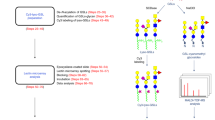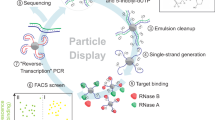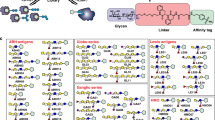Abstract
Glycans have important roles in living organisms with their structural diversity. Thus, glycomics, especially aspects involving the assignment of functional glycans in a high-throughput manner, has been an emerging field in the postproteomics era. To date, however, there has been no versatile method for glycan profiling. Here we describe a new microarray procedure based on an evanescent-field fluorescence-detection principle, which allows sensitive, real-time observation of multiple lectin-carbohydrate interactions under equilibrium conditions. The method allows quantitative detection of even weak lectin-carbohydrate interactions (dissociation constant, Kd > 10−6 M) as fluorescent signals for 39 immobilized lectins. We derived fully specific signal patterns for various Cy3-labeled glycoproteins, glycopeptides and tetramethylrhodamine (TMR)-labeled oligosaccharides. The obtained results were consistent with the previous reports of glycoprotein and lectin specificities. We investigated the latter aspects in detail by frontal affinity chromatography, another profiling method. Thus, the developed lectin microarray should contribute to creation of a new paradigm for glycomics.
This is a preview of subscription content, access via your institution
Access options
Subscribe to this journal
Receive 12 print issues and online access
$259.00 per year
only $21.58 per issue
Buy this article
- Purchase on Springer Link
- Instant access to full article PDF
Prices may be subject to local taxes which are calculated during checkout




Similar content being viewed by others
References
Apweiler, R., Hermjakob, H. & Sharon, N. On the frequency of protein glycosylation, as deduced from analysis of the SWISS-PROT database. Biochim. Biophys. Acta 1473, 4–8 (1999).
Varki, A., Cummings, R.D., Esko, J., Freeze, H. & Hart, G. Essentials of glycobiology. (Cold Spring Harbor Laboratory, New York, 1999).
Feizi, T. Progress in deciphering the information content of the 'glycome'—a crescendo in the closing years of the millennium. Glycoconj. J. 17, 553–565 (2000).
Hirabayashi, J. & Kasai, K. Glycomics, coming of age! Trends Glycosci. Glycotechnol. 12, 1–5 (2000).
Hirabayashi, J. Lectin-based structural glycomics: glycoproteomics and glycan profiling. Glycoconj. J. 21, 35–40 (2004).
Hirabayashi, J., Kaji, H., Isobe, T. & Kasai, K. Affinity capturing and gene assignment of soluble glycoproteins produced by the nematode Caenorhabditis elegans. J. Biochem. (Tokyo) 132, 103–114 (2002).
Hirabayashi, J. et al. Oligosaccharide specificity of galectins: a search by frontal affinity chromatography. Biochim. Biophys. Acta 1572, 232–254 (2002).
Bochner, B.S. et al. Glycan array screening reveals a candidate ligand for Siglec-8. J. Biol. Chem. 280, 4307–4312 (2005).
Kasai, K. & Ishii, S. Quantitative analysis of affinity chromatography of trypsin. A new technique for investigation of protein-ligand interaction. J. Biochem. (Tokyo) 77, 261–264 (1975).
Feizi, T., Fazio, F., Chai, W. & Wong, C.H. Carbohydrate microarrays - a new set of technologies at the frontiers of glycomics. Curr. Opin. Struct. Biol. 13, 637–645 (2003).
Wang, D., Liu, S., Trummer, B.J., Deng, C. & Wang, A. Carbohydrate microarrays for the recognition of cross-reactive molecular markers of microbes and host cells. Nat. Biotechnol. 20, 275–281 (2002).
Fukui, S., Feizi, T., Galustian, C., Lawson, A.M. & Chai, W. Oligosaccharide microarrays for high-throughput detection and specificity assignments of carbohydrate-protein interactions. Nat. Biotechnol. 20, 1011–1017 (2002).
Fazio, F., Bryan, M.C., Blixt, O., Paulson, J.C. & Wong, C.H. Synthesis of sugar arrays in microtiter plate. J. Am. Chem. Soc. 124, 14397–14402 (2002).
Blixt, O. et al. Printed covalent glycan array for ligand profiling of diverse glycan binding proteins. Proc. Natl. Acad. Sci. USA 101, 17033–17038 (2004).
Ratner, D.M. et al. Probing protein-carbohydrate interactions with microarrays of synthetic oligosaccharides. ChemBioChem 5, 379–383 (2004).
Ratner, D.M., Adams, E.W., Disney, M.D. & Seeberger, P.H. Tools for glycomics: mapping interactions of carbohydrates in biological systems. ChemBioChem 5, 1375–1383 (2004).
Stimpson, D.I. et al. Real-time detection of DNA hybridization and melting on oligonucleotide arrays by using optical wave guides. Proc. Natl. Acad. Sci. USA 92, 6379–6383 (1995).
Lehr, H.P., Reimann, M., Brandenburg, A., Sulz, G. & Klapproth, H. Real-time detection of nucleic acid interactions by total internal reflection fluorescence. Anal. Chem. 75, 2414–2420 (2003).
Angeloni, S. et al. Glycoprofiling with micro-arrays of glycoconjugates and lectins. Glycobiology 15, 31–41 (2005).
Pilobello, K.T., Krishnamoorthy, L., Slawek, D. & Mahal, L.K. Development of a lectin microarray for the rapid analysis of protein glycopatterns. ChemBioChem 6, 985–989 (2005).
Shinohara, Y. et al. Kinetic measurement of the interaction between an oligosaccharide and lectins by a biosensor on surface plasmon resonance. Eur. J. Biochem. 223, 189–194 (1994).
Mizuno, M., Noguchi, M., Imai, M., Motoyoshi, T. & Inazu, T. Interaction assay of oligosaccharide with lectins using glycosylasparagine. Bioorg. Med. Chem. Lett. 14, 485–490 (2004).
Yang, L., Tang, Q., Harrata, A.K. & Lee, C.S. Capillary isoelectric focusing-electrospray ionization mass spectrometry for transferrin glycoforms analysis. Anal. Biochem. 243, 140–149 (1996).
Knibbs, R.N., Perini, F. & Goldstein, I.J. Structure of the major concanavalin A reactive oligosaccharides of the extracellular matrix component laminin. Biochemistry 28, 6379–6392 (1989).
Wu, A.M., Wu, J.H., Herp, A. & Liu, J-H. Effect of polyvalencies of glycotopes on the binding of a lectin from the edible mushroom, Agaricus bisporus. Biochem. J. 371, 311–320 (2003).
Wuhrer, M., Hokke, C.H. & Deelder, A.M. Glycopeptide analysis by matrix-assisted laser desorption/ionization tandem time-of-flight mass spectrometry reveals novel features of horseradish peroxidase glycosylation. Rapid Commun. Mass Spectrom. 18, 1741–1748 (2004).
Wimmerova, M., Mitchell, E., Sanchez, J.F., Gautier, C. & Imberty, A. Crystal structure of fungal lectin: six-bladed beta-propeller fold and novel fucose recognition mode for Aleuria aurantia lectin. J. Biol. Chem. 278, 27059–27067 (2003).
Zhang, H., Li, X-J., Martin, D.B. & Aebersold, R. Identification and quantification of N-linked glycoproteins using hydrazide chemistry, stable isotope labeling and mass spectrometry. Nat. Biotechnol. 21, 660–666 (2003).
Kaji, H. et al. Lectin affinity capture, isotope-coded tagging and mass spectrometry to identify N-linked glycoproteins. Nat. Biotechnol. 21, 667–672 (2003).
Zhu, H. et al. Analysis of yeast protein kinases using protein chips. Nat. Genet. 26, 283–289 (2000).
Acknowledgements
We thank S. Nakamura, AIST, and K. Kasai, Teikyo University, for critical discussion about the lectin-carbohydrate interaction. We also thank M. Mizuno, the Noguchi Institute, and K. Hayama, AIST, for helpful advice about preparation of TAMRA-labeled oligosaccharide and glycopeptide mixture derived from ASF, respectively. This work was supported in part by New Energy and Industrial Technology Development Organization (NEDO) in Japan.
Author information
Authors and Affiliations
Corresponding author
Ethics declarations
Competing interests
Y.E. is employed by Moritex Co. and S.T. is employed by Nippon Laser & Electronics Lab. M.Y. is employed by both of these companies.
Supplementary information
Supplementary Fig. 1
Principle of the evanescent-field fluorescence-detection system and cutting model illustration of an optical scheme for the detection system. (PDF 224 kb)
Supplementary Fig. 2
Glycoproteins used in this study. (PDF 92 kb)
Supplementary Fig. 3
Determination of the Kd value of every lectin-glycan interaction. (PDF 21 kb)
Supplementary Fig. 4
Detection of lectin-glycopeptide interaction with lectin microarray. (PDF 257 kb)
Supplementary Table 1
Abbreviations for 39 lectins and their sugar binding specificities. (PDF 43 kb)
Supplementary Table 2
Standardization of signal intensity with hybrid array. (PDF 13 kb)
Rights and permissions
About this article
Cite this article
Kuno, A., Uchiyama, N., Koseki-Kuno, S. et al. Evanescent-field fluorescence-assisted lectin microarray: a new strategy for glycan profiling. Nat Methods 2, 851–856 (2005). https://doi.org/10.1038/nmeth803
Received:
Accepted:
Published:
Issue Date:
DOI: https://doi.org/10.1038/nmeth803
This article is cited by
-
Multiplexed discrimination of SARS-CoV-2 variants via plasmonic-enhanced fluorescence in a portable and automated device
Nature Biomedical Engineering (2023)
-
Linking aberrant glycosylation of plasma glycoproteins with progression of myelodysplastic syndromes: a study based on plasmonic biosensor and lectin array
Scientific Reports (2023)
-
Surface Glycan Profiling of Extracellular Vesicles by Lectin Microarray and Glycoengineering for Control of Cellular Interactions
Pharmaceutical Research (2023)
-
Exploring the In situ pairing of human galectins toward synthetic O-mannosylated core M1 glycopeptides of α-dystroglycan
Scientific Reports (2022)
-
Glycan expression profile of signet ring cell gastric cancer cells and potential applicability of rBC2LCN-targeted lectin drug conjugate therapy
Gastric Cancer (2022)



